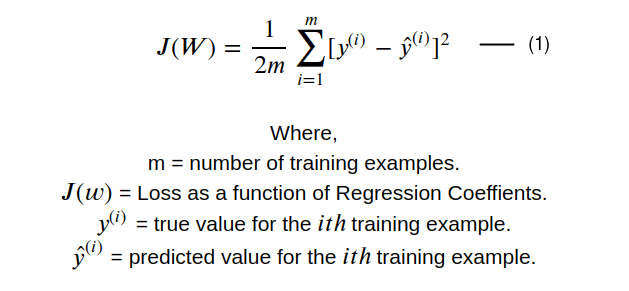
- In this blog post, we shall prove the convexity for the Mean Squared Error Loss function used in a traditional Regression setting.
- In case you haven’t checked out my previous blog — The Curious Case of Convex Functions, I would highly recommend you do. The blog focuses on the basic building blocks for proving/testing the convexity of a function.
With that in mind, let us start by reviewing –
- The MSE loss for a Regression Algorithm.
- Conditions for checking Convexity.
1. MSE Loss Function –
The MSE loss function in a Regression setting is defined as –
For checking the convexity of the Mean-Squared-Error function, we shall perform the following checks –
- Computing the Hessian of J(w)
- Computing the Principal Minors of the Hessian.
- Based on the values of principal minors, determine the definiteness of Hessian.
- Comment on Convexity based on convexity tests.
Let us get down to it right away-
- Computing the Hessian of J(w) –
2. Computing the Principal Minors –
From the previous blog post, we know that a function is convex if all the principal minors are greater than or equal to zero i.e. Δₖ ≥ 0 ∀ k
compute Δ₁ –
Principal Minors of order 1 (Δ₁) can be obtained by deleting any 3–1 = 2 rows and corresponding columns.
- By deleting row 2 and 3 along with corresponding columns Δ₁ = x₁²
- By deleting row 1 and 3 along with corresponding columns Δ₂ = x₂²
- By deleting row 1 and 2 along with corresponding columns Δ₃= x₃²
compute Δ₂ –
Principal Minors of order 2 can be obtained by deleting any 3–2 = 1 row and corresponding column.
- By deleting row 1 and corresponding column 1 –
- By deleting row 2 and corresponding column 2
- By deleting row 3 and corresponding column 3
compute Δ₃ –
Principal Minors of order 3 can be obtained by computing the determinant of J(W).
3. Comment on Definiteness of Hessian of J(w) –
- The principal minors of order 1 have a squared form. We know that a squared function is always positive.
- The principal minors of orders 2 and 3 are equal to zero.
- It can be concluded that Δₖ ≥ 0 ∀ k
- Hence the Hessian of J(w) is Positive Semidefinite (but not Positive Definite).
Step 4 Comment on convexity –
Before we comment on the convexity of J(w), let’s revise the conditions for convexity –
If Xᴴ is the Hessian Matrix of f(x) then –
- f(x) is strictly convex in 𝑆 if Xᴴ is a Positive Definite Matrix.
- f(x) is convex in 𝑆 if Xᴴ is a Positive Semi-Definite Matrix.
- f(x) is strictly concave in 𝑆 if Xᴴ is a Negative Definite Matrix.
- f(x) is concave in 𝑆 if Xᴴ is a Negative Semi-Definite Matrix.
Since the Hessian of J(w) is Positive Semidefinite, it can be concluded that the function J(w) is convex.
- This blog post is aimed at proving the convexity of MSE loss function in a Regression setting by simplifying the problem.
- There are different ways of proving the convexity but I found this easiest to comprehend.
- It is important to note that MSE is convex on its inputs and parameters but it may not be convex when used in the context of a Neural Network given the non-linearities introduced by the activation functions.
- Feel free to try out the process for different loss functions that you may have encountered.
